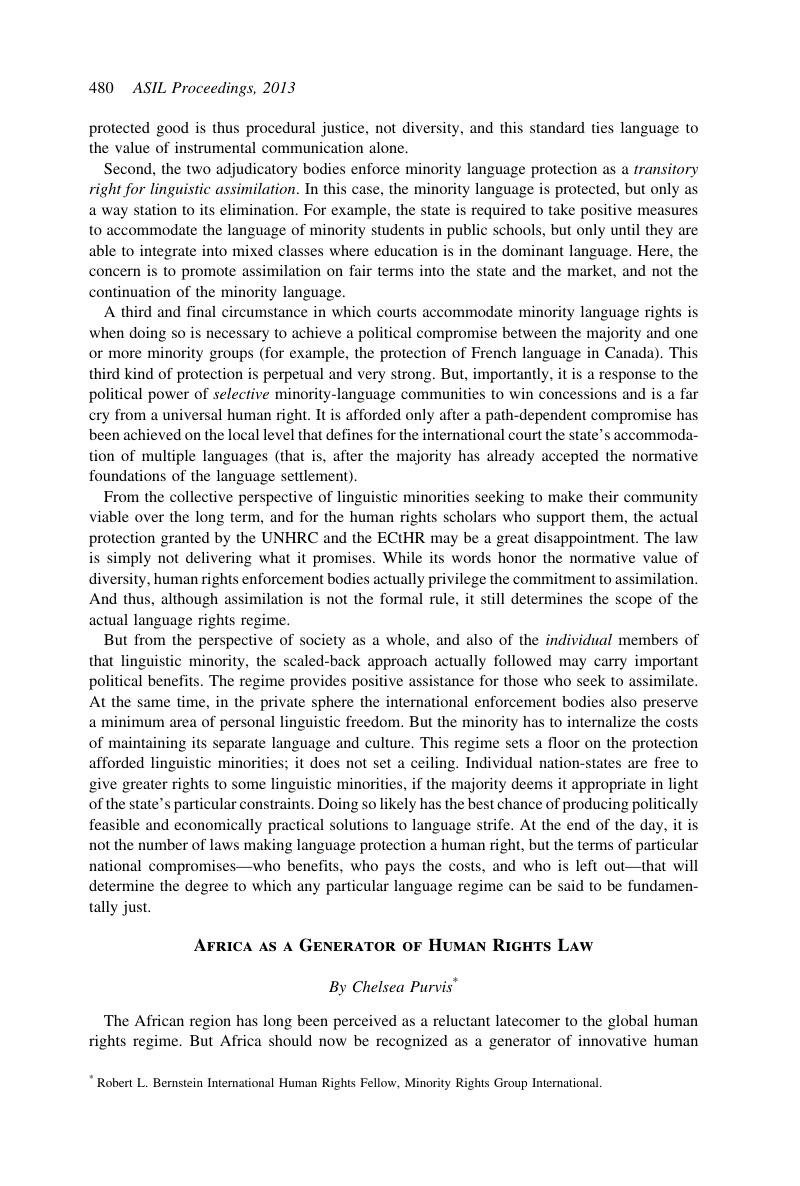Published online by Cambridge University Press: 20 January 2017

1 Protocol to the African Charter on Human and Peoples’ Rights on the Rights of Women in Africa, adopted July 11, 2003, http://www.africa-union.org/root/au/Documents/Treaties/Text/Protocol%20on%20the%20Rights%2-Oof%20Women.pdf [hereinafter Maputo Protocol].
2 Id. arts. 1(j), 3(4).
3 Id. art. 14(2)(c).
4 See Bond, Johanna, Gender, Discourse, and Customary Law in Africa, 83 S. Cal. L. Rev. 425, 427 (2010)Google Scholar (noting that the human rights community has historically depicted African cultures as a source of African women’s oppression).
5 See Viljoen, Frans, An Introduction to the Protocol to the African Charter on Human and Peoples’ Rights on the Rights of Women in Africa, 16 Wash. & Lee J. C R. & Soc. Just. 11, 19–20 (2010)Google Scholar (describing criticisms of the African Charter).
6 Maputo Protocol, supra note 1, arts. 7, 17.
7 Ctr. for Minority Rights Dev. (Kenya) & Minority Rights Grp. Int’l ex rel. Endorois Welfare Council v. Kenya, Comm’n No. 276/2003 (Afr. Comm’n Hum. & Peoples’ Rights 2010), http://www.escr-net.org/sites/default/files/Endorois_Decision.pdf [hereinafter Endorois Case].
8 The traditional “first nations” approach to indigenousness does not easily apply in Africa. The Commission instead adopts the emerging consensus that factors such as self-identification and relationship to ancestral land more accurately determine indigenousness. Endorois Case, supra note 7, paras. 151–62.
9 Id. paras. 185–237.
10 Id. para. 251.
11 Id. para. 227.
12 Inter-American Court of Human Rights, Case of the Saramaka People v. Suriname (Judgment of Nov. 28, 2007), paras. 134–36.
13 Endorois Case, supra note 7, para. 291.
14 Hadijatou Mani Koraou v. La Republic de Niger, Arret No. ECW/CCJ/JUD/06/08 (ECOWAS Cour de Justice Oct. 27, 2008), http://www.unhcr.org/refworld/docid/491168d42.html [hereinafter Mani Case], paras. 8–27.
15 Id. para. 85.
16 Duffy, Helen, Hadijatou Mani Koroua v. Niger: Slavery Unveiled by the ECOWAS Court, 9 Hum. Rts. L. Rev. 151, 151 (2009)Google Scholar.
17 Mani Case, supra note 12, paras. 77–79.
18 See Press Release, Minority Rights Group International, African Court Issues Historic Ruling Protecting Rights of Kenya’s Ogiek Community (Mar. 20, 2013), http://www.minorityrights.org/?lid=11822.
19 Council of Europe Convention on Preventing and Combating Violence Against Women and Domestic Violence art. 3(a), CETS No. 210 (2011); U.N. Comm. on the Rights of the Child, General Comment No. 13: The Right of the Child to Freedom from All Forms of Violence, para. 21, U.N. Doc. CRC/C/GC/13 (2011).
20 Inter-American Court of Human Rights, Case of the Kichwa Indigenous People of Sarayaku and Its Members v. Ecuador, (Judgment of June 27, 2012), para. 217.
21 Rantsev v. Cyprus and Russia, App. No. 25965/04 (Eur. Ct. H.R. 2010), para. 280.
22 See generally Sarkin, Jeremy, The African Commission on Human and People’s Rights and the Future African Court of Justice and Human Rights: Comparative Lessons from the European Court of Human Rights, 18 S. Afr. J. Int’l Aff. 281, 284–85 (2011)CrossRefGoogle Scholar.
23 The Council of Europe and the Committee on the Rights of the Child fail to credit the Maputo Protocol for inspiring their definitions of verbal abuse. See supra note 20 and accompanying text.
24 See, e.g., Opuz v. Turkey, paras. 83–86, App. No. 33401/02 (Eur. Ct. H.R. 2009).
25 See, e.g., Special Rapporteur on the Rights of Indigenous Peoples, Rep. of the Special Rapporteur on the Rights of Indigenous Peoples, Human Rights Council, U.N. Doc. A/HRC/21/47 (July 6, 2012) (by James Anaya).